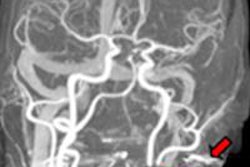By being aware of the causes of computed radiography (CR) and digital radiography (DR) image artifacts, users can develop appropriate countermeasures to reduce their occurrence, according to research presented at the 2007 RSNA meeting in Chicago.
"This will result in quality images and a good PACS environment," said Dr. Dong-Wook Sung of Kyung Hee University Hospital in Seoul, Republic of Korea. He presented the team's research during a scientific session at the show.
To analyze and classify the cause of image artifacts and develop a preventive method to handle them, the researchers studied 82 cases of image artifacts experienced during August 2005 and July 2006 from the institution's six CR and three DR systems. Artifacts resulting from a crack in the image plate were excluded because of its consistent occurrence, Sung said.
Of the 82 artifacts, 24 (29%) were from operator error, four (4.9%) were due to equipment being out of order, and four (4.9%) were attributed to the image plate, Sung said. The plate reader was to blame in 17 cases (21%), while image processing contributed 22 artifacts (26.8%). Data transfer issues led to seven artifacts (8.5%) and four were due to combined problems, he said.
Technician errors included improper radiation conditions and artifacts on patient clothes, as well as technical problems such as double exposure and over- or underexposure, according to Sung.
To prevent these errors, it's important to pay careful attention to CR operators, educating them about the CR system and appropriate managing of the image plate (including storage and correct use), he said. Out-of-order equipment issues included abnormal auto-exposure systems, a problem that can be solved by periodic checking of management programs, he said.
Image plate problems include those generated from the grid, cracks, and foreign materials such as hair and dust. To prevent image plate artifacts, users should use a grid greater than 60 lines per cm, Sung said. As was the case with preventing operator errors, careful management of the image plate is necessary.
Plate reader artifacts include those generated by incomplete erasure, dust on the light guide, problem on the polygon mirror, and static electricity. Appropriate prevention measures for these artifacts include performance of periodic, manual erasure, and ensuring that correct erasure settings are used every week, according to Sung. Maintaining clean optics is also important.
Image processing problems are mainly caused by improper setting of parameters, Sung said. To prevent these artifacts, it's important to set standards for image processing parameters and proper collimation, he said.
Data transfer problems included failed transfer of a total data to the PACS monitor, and this issue can be dealt with by checking the proper transfer speed and the total amount of data, he said.
"To reduce artifacts, monitoring, maintenance, and regular cleaning of PACS devices are most important," Sung said.
By Erik L. Ridley
AuntMinnie.com contributing writer
December 25, 2007
Related Reading
Healthcare IT makes for better patient outcomes, study finds, December 14, 2007
High-tech communication tools improve patient care, studies find, December 6, 2007
Developing a cost-effective image QA workflow with PACS, November 21, 2007
PACS data-mining technique tackles CR dose creep, July 30, 2007
DICOM-compliant displays aid CR/DR exposure control, July 17, 2007
Copyright © 2007 AuntMinnie.com



















